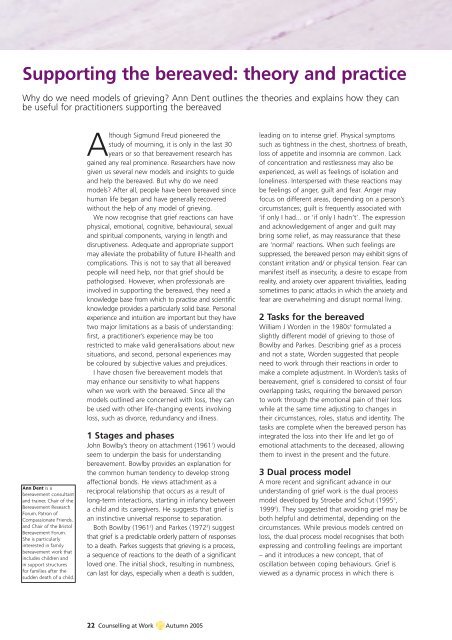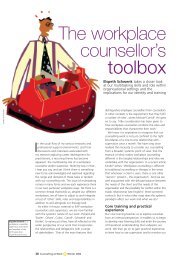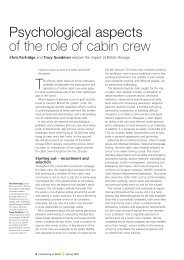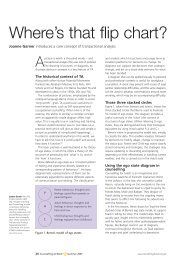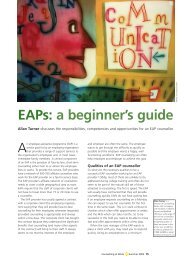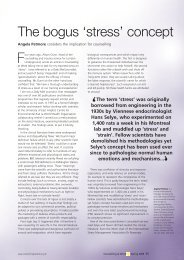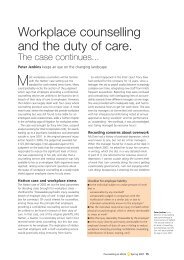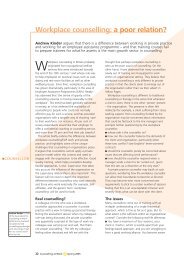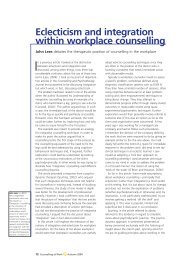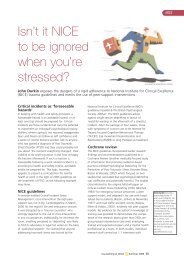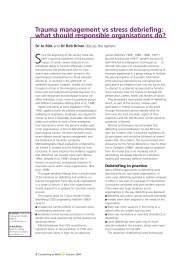Supporting the bereaved: theory and practice - BACP Workplace
Supporting the bereaved: theory and practice - BACP Workplace
Supporting the bereaved: theory and practice - BACP Workplace
Create successful ePaper yourself
Turn your PDF publications into a flip-book with our unique Google optimized e-Paper software.
<strong>Supporting</strong> <strong>the</strong> <strong>bereaved</strong>: <strong>the</strong>ory <strong>and</strong> <strong>practice</strong><br />
Why do we need models of grieving Ann Dent outlines <strong>the</strong> <strong>the</strong>ories <strong>and</strong> explains how <strong>the</strong>y can<br />
be useful for practitioners supporting <strong>the</strong> <strong>bereaved</strong><br />
Ann Dent is a<br />
bereavement consultant<br />
<strong>and</strong> trainer, Chair of <strong>the</strong><br />
Bereavement Research<br />
Forum, Patron of<br />
Compassionate Friends,<br />
<strong>and</strong> Chair of <strong>the</strong> Bristol<br />
Bereavement Forum.<br />
She is particularly<br />
interested in family<br />
bereavement work that<br />
includes children <strong>and</strong><br />
in support structures<br />
for families after <strong>the</strong><br />
sudden death of a child.<br />
Although Sigmund Freud pioneered <strong>the</strong><br />
study of mourning, it is only in <strong>the</strong> last 30<br />
years or so that bereavement research has<br />
gained any real prominence. Researchers have now<br />
given us several new models <strong>and</strong> insights to guide<br />
<strong>and</strong> help <strong>the</strong> <strong>bereaved</strong>. But why do we need<br />
models After all, people have been <strong>bereaved</strong> since<br />
human life began <strong>and</strong> have generally recovered<br />
without <strong>the</strong> help of any model of grieving.<br />
We now recognise that grief reactions can have<br />
physical, emotional, cognitive, behavioural, sexual<br />
<strong>and</strong> spiritual components, varying in length <strong>and</strong><br />
disruptiveness. Adequate <strong>and</strong> appropriate support<br />
may alleviate <strong>the</strong> probability of future ill-health <strong>and</strong><br />
complications. This is not to say that all <strong>bereaved</strong><br />
people will need help, nor that grief should be<br />
pathologised. However, when professionals are<br />
involved in supporting <strong>the</strong> <strong>bereaved</strong>, <strong>the</strong>y need a<br />
knowledge base from which to practise <strong>and</strong> scientific<br />
knowledge provides a particularly solid base. Personal<br />
experience <strong>and</strong> intuition are important but <strong>the</strong>y have<br />
two major limitations as a basis of underst<strong>and</strong>ing:<br />
first, a practitioner’s experience may be too<br />
restricted to make valid generalisations about new<br />
situations, <strong>and</strong> second, personal experiences may<br />
be coloured by subjective values <strong>and</strong> prejudices.<br />
I have chosen five bereavement models that<br />
may enhance our sensitivity to what happens<br />
when we work with <strong>the</strong> <strong>bereaved</strong>. Since all <strong>the</strong><br />
models outlined are concerned with loss, <strong>the</strong>y can<br />
be used with o<strong>the</strong>r life-changing events involving<br />
loss, such as divorce, redundancy <strong>and</strong> illness.<br />
1 Stages <strong>and</strong> phases<br />
John Bowlby’s <strong>the</strong>ory on attachment (1961 1 ) would<br />
seem to underpin <strong>the</strong> basis for underst<strong>and</strong>ing<br />
bereavement. Bowlby provides an explanation for<br />
<strong>the</strong> common human tendency to develop strong<br />
affectional bonds. He views attachment as a<br />
reciprocal relationship that occurs as a result of<br />
long-term interactions, starting in infancy between<br />
a child <strong>and</strong> its caregivers. He suggests that grief is<br />
an instinctive universal response to separation.<br />
Both Bowlby (1961 2 ) <strong>and</strong> Parkes (1972 3 ) suggest<br />
that grief is a predictable orderly pattern of responses<br />
to a death. Parkes suggests that grieving is a process,<br />
a sequence of reactions to <strong>the</strong> death of a significant<br />
loved one. The initial shock, resulting in numbness,<br />
can last for days, especially when a death is sudden,<br />
leading on to intense grief. Physical symptoms<br />
such as tightness in <strong>the</strong> chest, shortness of breath,<br />
loss of appetite <strong>and</strong> insomnia are common. Lack<br />
of concentration <strong>and</strong> restlessness may also be<br />
experienced, as well as feelings of isolation <strong>and</strong><br />
loneliness. Interspersed with <strong>the</strong>se reactions may<br />
be feelings of anger, guilt <strong>and</strong> fear. Anger may<br />
focus on different areas, depending on a person’s<br />
circumstances; guilt is frequently associated with<br />
‘if only I had... or ‘if only I hadn’t’. The expression<br />
<strong>and</strong> acknowledgement of anger <strong>and</strong> guilt may<br />
bring some relief, as may reassurance that <strong>the</strong>se<br />
are ‘normal’ reactions. When such feelings are<br />
suppressed, <strong>the</strong> <strong>bereaved</strong> person may exhibit signs of<br />
constant irritation <strong>and</strong>/ or physical tension. Fear can<br />
manifest itself as insecurity, a desire to escape from<br />
reality, <strong>and</strong> anxiety over apparent trivialities, leading<br />
sometimes to panic attacks in which <strong>the</strong> anxiety <strong>and</strong><br />
fear are overwhelming <strong>and</strong> disrupt normal living.<br />
2 Tasks for <strong>the</strong> <strong>bereaved</strong><br />
William J Worden in <strong>the</strong> 1980s 4 formulated a<br />
slightly different model of grieving to those of<br />
Bowlby <strong>and</strong> Parkes. Describing grief as a process<br />
<strong>and</strong> not a state, Worden suggested that people<br />
need to work through <strong>the</strong>ir reactions in order to<br />
make a complete adjustment. In Worden’s tasks of<br />
bereavement, grief is considered to consist of four<br />
overlapping tasks, requiring <strong>the</strong> <strong>bereaved</strong> person<br />
to work through <strong>the</strong> emotional pain of <strong>the</strong>ir loss<br />
while at <strong>the</strong> same time adjusting to changes in<br />
<strong>the</strong>ir circumstances, roles, status <strong>and</strong> identity. The<br />
tasks are complete when <strong>the</strong> <strong>bereaved</strong> person has<br />
integrated <strong>the</strong> loss into <strong>the</strong>ir life <strong>and</strong> let go of<br />
emotional attachments to <strong>the</strong> deceased, allowing<br />
<strong>the</strong>m to invest in <strong>the</strong> present <strong>and</strong> <strong>the</strong> future.<br />
3 Dual process model<br />
A more recent <strong>and</strong> significant advance in our<br />
underst<strong>and</strong>ing of grief work is <strong>the</strong> dual process<br />
model developed by Stroebe <strong>and</strong> Schut (1995 5 ,<br />
1999 6 ). They suggested that avoiding grief may be<br />
both helpful <strong>and</strong> detrimental, depending on <strong>the</strong><br />
circumstances. While previous models centred on<br />
loss, <strong>the</strong> dual process model recognises that both<br />
expressing <strong>and</strong> controlling feelings are important<br />
– <strong>and</strong> it introduces a new concept, that of<br />
oscillation between coping behaviours. Grief is<br />
viewed as a dynamic process in which <strong>the</strong>re is<br />
22 Counselling at Work Autumn 2005
an alternation between focusing on <strong>the</strong> loss of <strong>the</strong><br />
person who has died (loss orientation) <strong>and</strong> avoiding<br />
that focus (restoration orientation). The loss<br />
orientation encompasses grief work, while <strong>the</strong><br />
restoration orientation involves dealing with<br />
secondary losses as a result of <strong>the</strong> death. For<br />
instance, an older widow may have to deal with<br />
finances, <strong>and</strong> house maintenance, which previously<br />
her husb<strong>and</strong> dealt with.<br />
Both <strong>the</strong> loss orientation <strong>and</strong> <strong>the</strong> restoration<br />
orientation are necessary for future adjustment,<br />
but <strong>the</strong> degree <strong>and</strong> emphasis on each approach<br />
will depend on <strong>the</strong> circumstances of <strong>the</strong> death,<br />
personality, gender <strong>and</strong> cultural background of each<br />
person. The model also posits that by taking time off<br />
from <strong>the</strong> pain of grief, which can be overwhelming,<br />
a <strong>bereaved</strong> person may be more able to cope with<br />
<strong>the</strong>ir daily life <strong>and</strong> <strong>the</strong> secondary changes to it.<br />
4 Continuing bonds<br />
A fur<strong>the</strong>r important development in grief <strong>the</strong>ory<br />
has been provided by <strong>the</strong> work of Klass et al<br />
(1996 7 ), who challenged conventional thinking that<br />
<strong>the</strong> purpose of grieving was <strong>the</strong> reconstitution of<br />
an autonomous individual who could leave <strong>the</strong><br />
deceased behind <strong>and</strong> form new attachments, in<br />
o<strong>the</strong>r words, ’break <strong>the</strong> bonds’ with <strong>the</strong> deceased.<br />
Klass <strong>and</strong> his colleagues suggest that <strong>the</strong> purpose<br />
of grieving is instead to maintain a continuing<br />
bond with <strong>the</strong> deceased, compatible with o<strong>the</strong>r,<br />
new <strong>and</strong> continuing relationships.<br />
5 Families making sense of death<br />
Most models of grief deal with <strong>the</strong> grief of<br />
individuals. Frequently, however, death affects a<br />
whole family, in which family members, including<br />
children, can influence <strong>and</strong> be influenced by o<strong>the</strong>rs,<br />
<strong>and</strong> in which <strong>the</strong> death may mean different things<br />
to each. In many cases, <strong>the</strong> family is very often <strong>the</strong><br />
prime provider of socialisation, social control <strong>and</strong><br />
support. Certain factors ei<strong>the</strong>r inhibit or enhance<br />
a family’s grief. Families in which <strong>the</strong>re are fragile<br />
relationships, secrets <strong>and</strong> divergent beliefs may<br />
have more difficulty in adjusting; whereas families<br />
who have frequent contact, rituals <strong>and</strong> a willingness<br />
for each member to share <strong>the</strong>ir feelings, may find<br />
it easier.<br />
Summary<br />
Most models of grief suggest that <strong>the</strong> <strong>bereaved</strong><br />
need to engage with <strong>the</strong>ir loss <strong>and</strong> work through<br />
it, so that life can be reordered <strong>and</strong> meaningful<br />
again. Most practitioners will be familiar with<br />
<strong>the</strong> stage/phase <strong>the</strong>ories in identifying cognitive,<br />
social <strong>and</strong> emotional factors. Worden’s tasks of<br />
bereavement give a framework to guide <strong>the</strong><br />
<strong>bereaved</strong> in <strong>the</strong>ir grief work, while <strong>the</strong> dual<br />
process model demonstrates <strong>the</strong> need to deal<br />
with secondary stresses as well as <strong>the</strong> primary loss,<br />
with time away from both. It is also important to<br />
recognise that <strong>the</strong> <strong>bereaved</strong> do not need to forget<br />
<strong>and</strong> leave <strong>the</strong> deceased behind, but can integrate<br />
<strong>the</strong>m into <strong>the</strong>ir future lives by means of a continuing<br />
bond. While most research has focused on <strong>the</strong><br />
individual, underst<strong>and</strong>ing <strong>the</strong> family dynamic is<br />
often of great importance for counsellors in<br />
identifying possible tensions between members<br />
<strong>and</strong> assessing how members may influence or be<br />
influenced by o<strong>the</strong>rs, as well as underst<strong>and</strong>ing<br />
what <strong>the</strong> death means to each member.<br />
Each <strong>bereaved</strong> person is unique <strong>and</strong> will deal<br />
with a significant death in <strong>the</strong>ir own way; <strong>the</strong>refore<br />
<strong>the</strong>re is no one right or wrong way to grieve. The<br />
challenge that faces practitioners each time we<br />
meet a <strong>bereaved</strong> person is to find what helps <strong>the</strong>m<br />
best. No single model of grieving is recommended<br />
above <strong>the</strong> rest, as all have various components that<br />
may be helpful. Regardless of which model is used,<br />
<strong>the</strong> most important part of supporting a <strong>bereaved</strong><br />
person lies in ‘being with’ <strong>the</strong>m, listening intently<br />
to <strong>the</strong>ir story, acknowledging <strong>the</strong>ir feelings <strong>and</strong><br />
guiding <strong>the</strong>m to work towards a new, different<br />
<strong>and</strong> meaningful life without <strong>the</strong> deceased. ■<br />
References<br />
1 Bowlby J. Processes of mourning. International<br />
journal of psychoanalysis. 1961;42:317-39.<br />
2 Bowlby J. Attachment <strong>and</strong> loss Vol 3. 1st ed. New<br />
York: Basic Books; 1981.<br />
3 Parkes CM. Bereavement: studies in grief in adult<br />
life. London: Tavistock; 1972.<br />
4 Worden JW. Grief counselling <strong>and</strong> grief <strong>the</strong>rapy, 1st<br />
ed. London: Tavistock; 1983.<br />
5 Stroebe M, Schut H. The dual process model of<br />
coping with loss. Paper presented at <strong>the</strong> International<br />
workgroup on death, dying <strong>and</strong> bereavement.<br />
Oxford, UK: 1995.<br />
6 Stroebe M, Schut H. The dual process model of<br />
coping with bereavement: rationale <strong>and</strong> description.<br />
Death studies. 1999;23:197-224.<br />
7 Klass D, Silverman S, Nickman S (eds). Continuing<br />
bonds: new underst<strong>and</strong>ings of grief. Washington:<br />
Taylor <strong>and</strong> Francis; 1996.<br />
This article was first published in <strong>the</strong> July 2005 issue<br />
of <strong>the</strong> Healthcare Counselling <strong>and</strong> Psycho<strong>the</strong>rapy<br />
Journal; this edited version is reprinted with thanks.<br />
For subscriptions, tel 0870 443 5252 or email<br />
membership@bacp.co.uk<br />
INGRAM PUBLISHING/ALAMY<br />
Counselling at Work Autumn 2005 23


